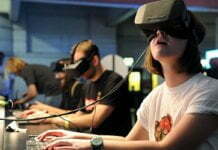“Driving force.” Is there a more customary title? It is no longer just an undeniable phrase. In the spirit of bland amusement advertising and marketing, it tells you precisely what type of game you’re supposed to shop for. Shooter. Platformer. Driving force. This should be a recreation with a novel motive—the auto chases might be fun, but automobile chases, presumably, are all you may get.
However, there may be an alternative half of “San Francisco.” If writer Walt Williams chose Dubai to symbolize Spec Ops: the line’s grander topics—if the town’s fullness and grandeur, violently eroded via a sandstorm, meditated the mental deterioration of Captain Martin Walker—I might want to think San Francisco says something of motive force’s variety and coloration, its heterogeneity. San Francisco has become synonymous with cultural experimentation and alternative thinking throughout the twentieth century. Recalling the city in its 1960s heyday, Hunter Thompson wrote, “There has been madness in any path… you may strike sparks everywhere.” If it not for its famously bumpy roads or its association with the movie Bullit, San Francisco, and extensively well-known Middle of Innovative Freedom is the precise putting for 2011’s motive force—regardless of flaunting an adherence to style, this is an unorthodox sport, replete with range.
“Range,” to some recreation makers, can suggest ugly and unfortunate things. Assassin’s Creed’s idea of “variety” is infinite aspects of missions and collectibles. In Saints Row and just motive, “variety” way idiocy: big weapons, slapstick physics engines, and myriad vain approaches for gamers to “express themselves.” it’s a shame that these days when I am told a sport is “unique,” “madcap,” or “numerous,” I am right away suspicious. Driving force: San Francisco is all of these things; however, virtually now, not within the bastardized, dragged-through-the-mud feel that I associate with video games. There are plenty of factors to do and notice in motive force, and they all are exciting.
 If you aren’t acquainted with the sport’s narrative set-up, it’s one of the smartest in mainstream gaming. As the eponymous driving force, Tanner, you are caught in a coma following a car crash. By hitting an unmarried button, at any time, you may waft out of your frame and into different people—perhaps you see a child struggling together with his driving. Take a look, so you bounce into him and suddenly wow his trainer with professional cornering and precision a hundred and eighty spins. Now and then, you are a college scholar trying to win street races to pay for training. At different times, you’re a hapless beat cop thrust right into a high-pace chase. Using his superpower, Tanner, in short, enjoys life as masses of different San Franciscans. What can be an instantly up-riding game, fixated on the rote global of police officers and robbers, becomes a cleaning soap opera, a melodrama, a comedy.
If you aren’t acquainted with the sport’s narrative set-up, it’s one of the smartest in mainstream gaming. As the eponymous driving force, Tanner, you are caught in a coma following a car crash. By hitting an unmarried button, at any time, you may waft out of your frame and into different people—perhaps you see a child struggling together with his driving. Take a look, so you bounce into him and suddenly wow his trainer with professional cornering and precision a hundred and eighty spins. Now and then, you are a college scholar trying to win street races to pay for training. At different times, you’re a hapless beat cop thrust right into a high-pace chase. Using his superpower, Tanner, in short, enjoys life as masses of different San Franciscans. What can be an instantly up-riding game, fixated on the rote global of police officers and robbers, becomes a cleaning soap opera, a melodrama, a comedy.
READ MORE :
- Bihar: 20-year-old shot dead after overtaking car of JD(U) leader’s son
- Six tips for wearing a cycling cap properly
- With smartphone vulnerabilities skyrocketing, here are nine things you can do to stay safe
- US universities aren’t necessarily the best. But that doesn’t seem to matter.
- What was your first Android phone?
‘Motive force: San Francisco,’ gameplay trailer
And it is lovingly written, too. It takes one, maybe two missions for Tanner to end up accustomed to his capacity and the fact he is in a coma, and from there on, he’s, in reality, up for whatever. Like Deadly Premonition’s Francis York Morgan, certainly one of my favorite online game characters, who, while facing my monsters and ghosts, shrugs and gets on with it, Tanner does not worry or navel-gaze—as much as I do; he is enjoying the ride. And that’s what offers motive force its energy. Hopping among characters is one element, but the manner driver’s writers at Ubisoft Reflections (Ian Mayor, James Worrall, and David Midgley) never get slowed down in “what all of it manner”—the way they cleanly and crisply install each vignette, and then let them roll with absolute willing—represents the self-belief of typical sport makers, all too regularly, appear to lack.
Openness to experimentation and a creative attitude, possibly best surmised as “positive, why now not?” are things I recognize extremely. Under the two rubrics, video games regularly peddle the stupidest and basest entertainment. Driver: San Francisco is the uncommon instance of a sport boldly willing to be one-of-a-kind, to challenge the well-known standards of its style and the franchise that gives it its call, with our degenerating into idiocy. Its body-swapping mechanic, which opens motive force as much as many new characters and contexts for missions, is authentic and bizarre in the noblest feel. Strapping your man or woman to a flying gas tank or beating pedestrians to demise with a gigantic flopping dildo isn’t.





